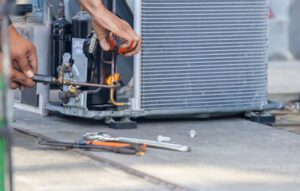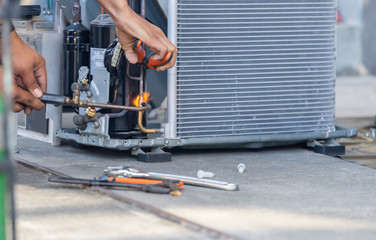Heating and air conditioning are fundamental processes that control the temperature, humidity, and purification of air in a building. HVAC uses a thermostat to adjust these settings and keep the space comfortable. It is used in a variety of different settings, including homes, offices, and retail stores. 
HVAC stands for heating, ventilation, and air-conditioning and refers to the various systems used to maintain temperature and humidity in a home or office. This system helps keep indoor environments comfortable for humans and can remove smoke, dust, and bacteria. A system that is properly installed and maintained can keep a home or office cool during the summer and warm during the winter.
Ventilation is a vital process for controlling indoor temperatures. An HVAC system draws fresh air from the outside of a building and filters it. This clean air is then circulated through ducts. These ducts are essential for central heating and cooling systems. An air conditioner, on the other hand, removes moisture and changes the indoor temperature to a preset temperature.
HVAC systems are an integral part of residential, medium-large industrial, and office buildings. They also play a critical role in vehicles, hospitals, and marine environments. These systems help to regulate temperature and humidity inside buildings by using fresh air from the outdoors. Those in need of an HVAC system should contact a company that offers HVAC installation services.
An HVAC system consists of a heating unit, a cooling unit, and a duct system to move the heated air throughout a home. The heating unit is the furnace, and it takes up most of the space in an HVAC system. The efficiency of a furnace is determined by its Annual Fuel Utilization Efficiency (AFUE) rating. Generally, a furnace with an AFUE rating of eighty percent or greater is considered highly efficient.
Heating and air conditioning (HVAC) systems are used to control the temperature, humidity, and air quality in a building. The process of selecting an HVAC system is based on a variety of factors, including climate, age of the building, and individual preferences of the building owner and designer. In addition, the architectural design of a building can also influence the selection of HVAC systems.
Thermostats are a great way to keep your home at a comfortable temperature. They work as a closed-loop control system that tries to minimize the difference between the desired and measured temperature. Thermostats come in wide varieties and have different features. Understanding the different settings on a thermostat can help you choose the best settings for your home and budget.
A thermostat works by using electricity to control the temperature in a room. The thermostat is powered by a transformer and connects to a 24-volt power source. The thermostat then activates a relay in the heating or air conditioning system. This relay then starts the heater or fan, or both.
Thermostats can be either analog or digital. The digital thermostat uses a thermistor to measure temperature. A thermistor is an electrical device that changes resistance with temperature. The microcontroller in a digital thermostat can measure the resistance and convert it into a temperature reading.
Thermostats can also be programmed to set the temperature. If the thermostat is programmed to “Auto” mode, the fans will only run if the temperature in the room is higher than the setpoint. This reduces energy use and lowers energy bills. Moreover, it prevents the air in the room from getting too hot or too cold.
A heat exchanger is a type of cooling and heating system that transfers heat from one fluid to another. This type of system is usually made of two parts: the heat exchanger and the cooling coil. These two pieces of equipment are not physically in contact, so the heat transfer is done without the use of direct contact. Heat exchangers come in a variety of forms, including shell and tube, U tube, helical, and more. They are usually used for heat transfer between two fluids, such as air and water or steam.
Heat exchangers are used in a variety of HVAC systems. They help cool buildings while heating homes and businesses. They help make heating and cooling machines more efficient. This type of system can be found in air conditioning systems as well as gas furnaces. Using heat exchangers can help your system to use less energy and create a more comfortable environment.

